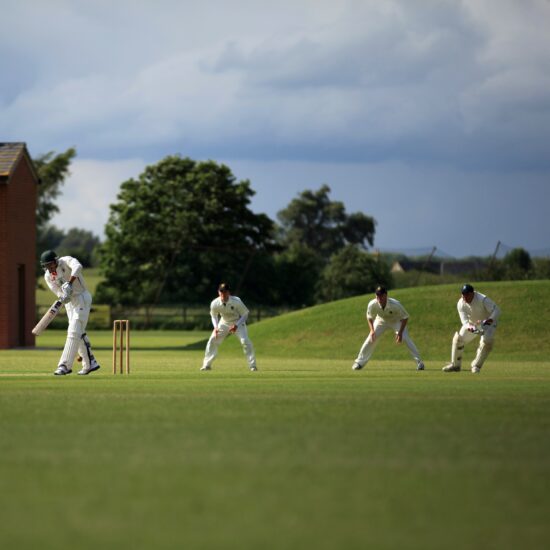Tata Communications’ Brian Morris, highlights digital technology’s part in enhancing how people view global sports events.
Despite being known around the world for its long history and traditional values, cricket has embraced technology more enthusiastically than perhaps any other sport on the planet. With the 2019 World Cup underway in England and Wales, technology now plays a bigger part in the sport than ever before… but can it go further still?
Playing by the rules
 While many of cricket’s key technologies exist primarily for the purpose of officiating, broadcasters are given access to data feeds to help inform spectators at home. Hawk-Eye, which uses cameras to track the path of the ball and inform LBW decisions, and UltraEdge and Hot Spot, which use powerful microphones and infrared cameras respectively to determine whether a player’s bat has made contact with the ball, make up a trio of tools that have been used by umpires for a number of years to inform on-field rulings. They are now so ubiquitous in cricket that they’ve become household names for fans of the sport.
While many of cricket’s key technologies exist primarily for the purpose of officiating, broadcasters are given access to data feeds to help inform spectators at home. Hawk-Eye, which uses cameras to track the path of the ball and inform LBW decisions, and UltraEdge and Hot Spot, which use powerful microphones and infrared cameras respectively to determine whether a player’s bat has made contact with the ball, make up a trio of tools that have been used by umpires for a number of years to inform on-field rulings. They are now so ubiquitous in cricket that they’ve become household names for fans of the sport.
Hawk-Eye, in particular, has expanded its offering to include Synchronised Multi-Angle Replay Technology (SMART), which makes all its camera angles available to third umpires in real time and uses software to automate certain cameras and production processes in order to streamline the workflow of live coverage teams.
Yet, the evolution of the rules of the game – set before technological innovations revolutionised how it is officiated – is a topic that is actively debated in cricketing circles in light of recent events. Zing bails, a fairly new addition to the sport, have embedded technology which illuminates LED lights in the bails and stumps within one-thousandth of a second of ‘impact’. They are designed to eliminate guesswork when the bails are dislodged, especially during runouts. This technology has helped drive significant improvements in decision making for the umpires.
 However, in a game decided by fine margins at the highly anticipated encounter between India and Australia at the Kensington Oval, David Warner became the fifth batsman in this year’s World Cup to get a reprieve due to non-dislodged bails after the ball hit the stumps. A perfect short of a length delivery bowled by Jasprit Bumrah at above 140 km/h took a healthy inside edge, and ‘hit’ the leg stump – but did not dislodge the bails despite the collective wishes of 20,000 fans in the stadium and millions watching worldwide. Regardless of this anomaly, India did go on to win the match in a riveting encounter, which many of my colleagues were delighted about!
However, in a game decided by fine margins at the highly anticipated encounter between India and Australia at the Kensington Oval, David Warner became the fifth batsman in this year’s World Cup to get a reprieve due to non-dislodged bails after the ball hit the stumps. A perfect short of a length delivery bowled by Jasprit Bumrah at above 140 km/h took a healthy inside edge, and ‘hit’ the leg stump – but did not dislodge the bails despite the collective wishes of 20,000 fans in the stadium and millions watching worldwide. Regardless of this anomaly, India did go on to win the match in a riveting encounter, which many of my colleagues were delighted about!
What remains to be seen is if the sport will change its rules and get rid of the bails now that we have the technology that illuminates the stumps on impact.
“This will be a true test of how technology helps the game become even more precise without radical shifts in the way it has been played over centuries.”
Bringing fans closer to the action
Our the recent report “Show Me the Money!” highlighted that “sports and broadcasters can monetise big data by helping viewers understand what they’re watching as well as creating more targeted content, which can be distributed to audiences from different geographies, cultures and age-groups.”
 With so many more people watching at home, and a general push by the sport to engage with younger fans, this year the International Cricket Council (ICC) has partnered with ByteDance – the Chinese technology company behind TikTok (the world’s most downloaded app in 2018) and Helo, a social network that’s particularly popular in India. The former allows fans to take part in cricket-based challenges, while the latter offers news from the World Cup in 14 local Indian languages.
With so many more people watching at home, and a general push by the sport to engage with younger fans, this year the International Cricket Council (ICC) has partnered with ByteDance – the Chinese technology company behind TikTok (the world’s most downloaded app in 2018) and Helo, a social network that’s particularly popular in India. The former allows fans to take part in cricket-based challenges, while the latter offers news from the World Cup in 14 local Indian languages.
The ICC also uses its own digital channels, including Facebook, YouTube, Instagram, Twitter and its own app (including a ‘Lite’ version), to keep fans in touch with the action wherever they are. This includes two digital-only video broadcasts, at the beginning and end of each day’s play. To reflect the game’s multinational popularity, particularly in the Indian subcontinent, much of the content is available in English, Hindi, Bengali and Urdu.
Aarti Dabas, the ICC’s Head of Media Rights and Digital was recently quoted as saying, “As a sport we’re committed to building partnerships with companies that offer us the use of a range of platforms to connect and engage with our fans in a meaningful way. The multi-language format of Helo also allows us to increase our reach across India bringing more fans closer to the event than ever before.”
While the digital audience might dwarf that at the grounds, the ICC’s app also includes functionality that’s designed purely for fans at the matches, with beacons on the ground to provide information to match-going fans via push notifications. Hawk-Eye’s latest SMART Vote tech is deployed on the big screens in stadiums and uses branded voting cards and sophisticated vision processing technology to allow fans to have their say on the game’s big decisions without having to reach into their pockets for their phones. Sponsors can also use it to engage with the crowd during the game’s relatively frequent breaks in play.
In the future, cricket’s use of data is only going to get more sophisticated. Players are already wearing sensors to record their physical efforts, while a bat-mounted sensor called Batsense has been trialled by players including Aaron Finch and David Warner, offering greater insights into discrete actions and overall performances by recording bat speed, back-lift and follow-through.
With plans to integrate similar technology into balls, shoes and helmets, the data collected will be used to provide an increasingly complete picture of what’s happening on the wicket, whether you’re at Trent Bridge, Galle, the bus stop or in the bath!
What are the untapped revenues for global sports? Read about it in our previous blog.
Tata Communications was the Official Connectivity Provider of Formula 1® between 2012 and 2019. Tata Communications was also the Official Managed Connectivity Supplier to Mercedes-AMG Petronas Motorsport, and Official Digital Transformation Partner to ROKiT Williams Racing until the end of the 2019 season.
Transformational Hybrid SolutionsOur cloud-enablement services offer the best performance on your traffic-heavy websites or mission-critical applications.
Core NetworksTata Communications™ global IT infrastructure and fibre network delivers the resources you need, when and where you need them.
Network Resources
Unified Communications As A ServiceBreak the barriers of borders efficiently and increase productivity with Tata Communications’ UC&C solutions.
Global SIP ConnectEmpower your business with our SIP network and witness it grow exponentially.
InstaCC™ - Contact Centre As A ServiceCloud contact centre solutions for digital customers experience and agent productivity.
Unified Communication Resources Case studies, industry papers and other interesting content to help you explore our unified communications solution better.
IoT SolutionsThe Internet of Things is transforming the way we experience the world around us for good. Find out more about our Internet Of Things related solutions here.
Mobility SolutionsTata Communications’ mobility services enable your enterprise to maintain seamless communication across borders, with complete visibility of cost and usage.
Mobility & IoT Resources
Multi-Cloud SolutionsWith enterprises transitioning to a hybrid multi-cloud infrastructure, getting the right deployment model that yields ROI can be a daunting task.
Cloud ComplianceCompliant with data privacy standards across different countries and is also designed to protect customers’ privacy at all levels.
IZO™ Cloud Platform & ServicesIZO™ is a flexible, one-stop cloud enablement platform designed to help you navigate complexity for more agile business performance.
Managed Infrastructure ServicesIntegrated with our integrated Tier-1 network to help your business grow efficiently across borders.
Cloud PartnersWe support a global ecosystem for seamless, secure connectivity to multiple solutions through a single provider.
Cloud Resources
Governance, Risk, and ComplianceRisk and Threat management services to reduce security thefts across your business and improve overall efficiencies and costs.
Cloud SecurityBest-in-class security by our global secure web gateway helps provide visibility and control of users inside and outside the office.
Threat Management - SOCIndustry-leading threat-management service to minimise risk, with an efficient global solution against emerging security breaches and attacks.
Advanced Network SecurityManaged security services for a predictive and proactive range of solutions, driving visibility and context to prevent attacks.
Cyber Security ResourcesCase studies, industry papers and other interesting content to help you explore our securtiy solution better.
Hosted & Managed ServicesTata Communications provide new models for efficient wholesale carrier voice service management. With our managed hosting services make your voice business more efficient and better protected
Wholesale Voice Transport & Termination ServicesYour long-distance international voice traffic is in good hands. End-to-end, voice access & carrier services which includes voice transport and termination with a trusted, global partner.
Voice Access ServicesTata Communication’s provide solutions which take care of your carrier & voice services, from conferencing to call centre or business support applications.
Carrier Services Resources
CDN Acceleration ServicesOur CDN Web Site Acceleration (WSA) solution helps deliver static and dynamic content, guaranteeing higher performance for your website.
CDN SecuritySafeguard your website data and customers’ information by securing your website from hacks and other mala fide cyber activities.
Video CDNDeliver high-quality video content to your customers across platforms – website, app and OTT delivery.
CDN Resources
Elevate CXIncrease customer satisfaction while empowering your service team to deliver world-class customer experience and engagement.
Live Event ServicesTata Communications’ live event services help battle the share if eyeballs as on-demand video drives an explosion of diverse content available on tap for a global audience.
Media Cloud Infrastructure ServicesTata Communications’ media cloud infrastructure offers flexible storage & compute services to build custom media applications.
Global Media NetworkTata Communications’ global media network combines our expertise as a global tier-1 connectivity provider with our end-to-end media ecosystem.
Use CasesUse cases of Tata Communications’ Media Entertainment Services
Remote Production SolutionsMedia contribution, preparation and distribution are highly capital-intensive for producers of live TV and video content, and their workflows are complex.
Media Cloud Ecosystem SolutionsThe Tata Communications media cloud infrastructure services offer the basic building blocks for a cloud infrastructure-as-a-service.
Global Contribution & Distribution SolutionsTata Communications’ global contribution and distribution solution is built to reduce capital outlay and grow global footprint.
Satellite Alternative SolutionsAs more and more consumers choose to cut the cord & switch to internet-based entertainment options, broadcasters are faced with capital allocation decisions.
LeadershipA look into the pillars of Tata communications who carry the torch and are living embodiment of Tata’s values and ethos.
Culture & DiversityHere at Tata Communications we are committed to creating a culture of openness, curiosity and learning. We also believe in driving an extra mile to recognize new talent and cultivate skills.
OfficesA list of Tata Communications office locations worldwide.
FAQCheck out our FAQs section for more information.
SustainabilityOur holistic sustainability strategy is grounded in the pillars of People, Planet and Community with corporate governance at the heart of it.
BoardHave a look at our board of members.
ResultsFind out more about our quarterly results.
Investor PresentationsFollow our repository of investor presentations.
FilingsGet all information regarding filings of Tata communications in one place.
Investor EventsAll investor related event schedule and information at one place.
GovernanceAt Tata, we believe in following our corporate social responsibility which is why we have set up a team for corporate governance.
SharesGet a better understanding of our shares, dividends etc.
SupportGet all investor related contact information here.


